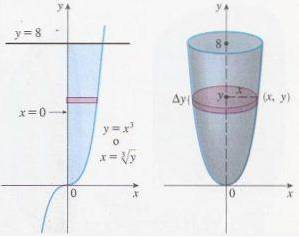
What Types of Integrals Are There?

The types of integrals that we find in the calculus are the indefinite integrals and the definite integrals. Although definite integrals have many more applications than indefinite integrals, it is necessary first to learn how to solve indefinite integrals..
One of the most attractive applications of definite integrals is the calculation of the volume of a solid of revolution. Both types of integrals have the same linearity properties and also the integration techniques do not depend on the type of integral..

But despite being very similar, there is one main difference; in the first type of integral the result is a function (which is not specific) while in the second type the result is a number.
Basic types of integrals
The world of integrals is very broad, but within it we can distinguish two basic types of integrals, which have great applicability in everyday life..
1- Indefinite integrals
If F '(x) = f (x) for all x in the domain of f, we say that F (x) is an antiderivative, a primitive, or an integral of f (x).
On the other hand, let us observe that (F (x) + C) '= F' (x) = f (x), which implies that the integral of a function is not unique, since giving different values to the constant C we will obtain different antiderivatives.
For this reason F (x) + C is called the Indefinite Integral of f (x) and C is called the constant of integration and we write it as follows

As we can see, the indefinite integral of the function f (x) is a family of functions.
For example, if you want to calculate the indefinite integral of the function f (x) = 3x², you must first find an antiderivative of f (x).
It is easy to see that F (x) = x³ is an antiderivative, since F '(x) = 3x². Therefore, it can be concluded that
∫f (x) dx = ∫3x²dx = x³ + C.
2- Definite integrals
Let y = f (x) be a real, continuous function on a closed interval [a, b] and let F (x) be an antiderivative of f (x). The definite integral of f (x) between the limits a and b is called the number F (b) -F (a), and is denoted as follows

The formula shown above is better known as "The Fundamental Theorem of Calculus." Here "a" is called the lower limit and "b" is called the upper limit. As you can see, the definite integral of a function is a number.
In this case, if we calculate the definite integral of f (x) = 3x² in the interval [0,3], we will obtain a number.
To determine this number we choose F (x) = x³ as the antiderivative of f (x) = 3x². Then, we calculate F (3) -F (0) which gives us the result 27-0 = 27. In conclusion, the definite integral of f (x) on the interval [0,3] is 27.
It can be noted that if G (x) = x³ + 3 is chosen, then G (x) is an antiderivative of f (x) different from F (x), but this does not affect the result since G (3) -G ( 0) = (27 + 3) - (3) = 27. For this reason, in the definite integrals the constant of integration does not appear.
One of the most useful applications of this type of integral is that it allows to calculate the area (volume) of a plane figure (of a solid of revolution), establishing suitable functions and limits of integration (and an axis of rotation).
Within the defined integrals we can find various extensions of it, such as line integrals, surface integrals, improper integrals, multiple integrals, among others, all with very useful applications in science and engineering..
References
- Casteleiro, J. M. (2012). Is it easy to integrate? Self-study manual. Madrid: ESIC.
- Casteleiro, J. M., & Gómez-Álvarez, R. P. (2002). Integral calculus (Illustrated ed.). Madrid: ESIC Editorial.
- Fleming, W., & Varberg, D. E. (1989). Precalculus Mathematics. Prentice Hall PTR.
- Fleming, W., & Varberg, D. E. (1989). Precalculus mathematics: a problem-solving approach (2, Illustrated ed.). Michigan: Prentice Hall.
- Kishan, H. (2005). Integral Calculus. Atlantic Publishers & Distributors.
- Purcell, E. J., Varberg, D., & Rigdon, S. E. (2007). Calculation (Ninth ed.). Prentice hall.



Yet No Comments